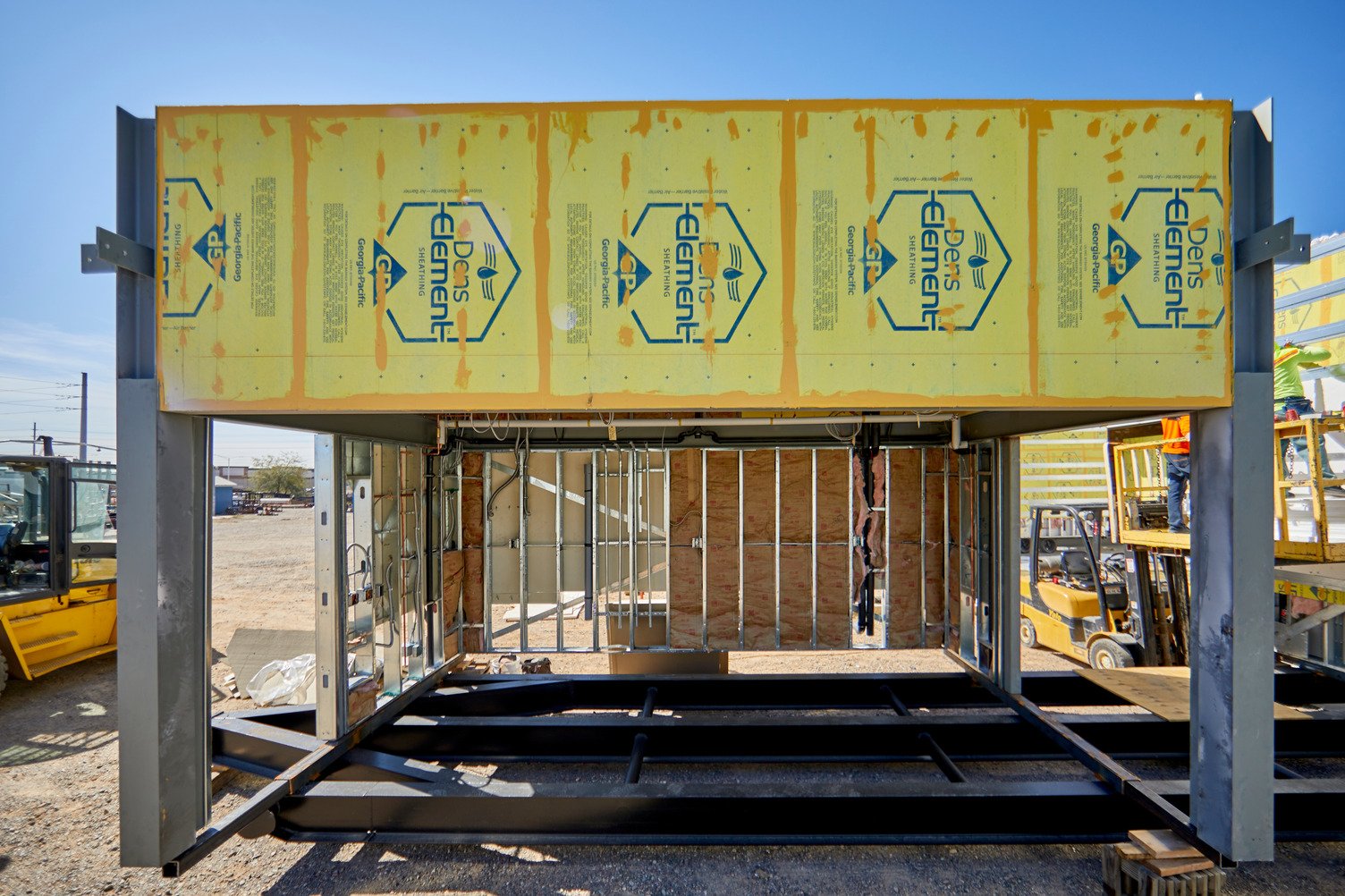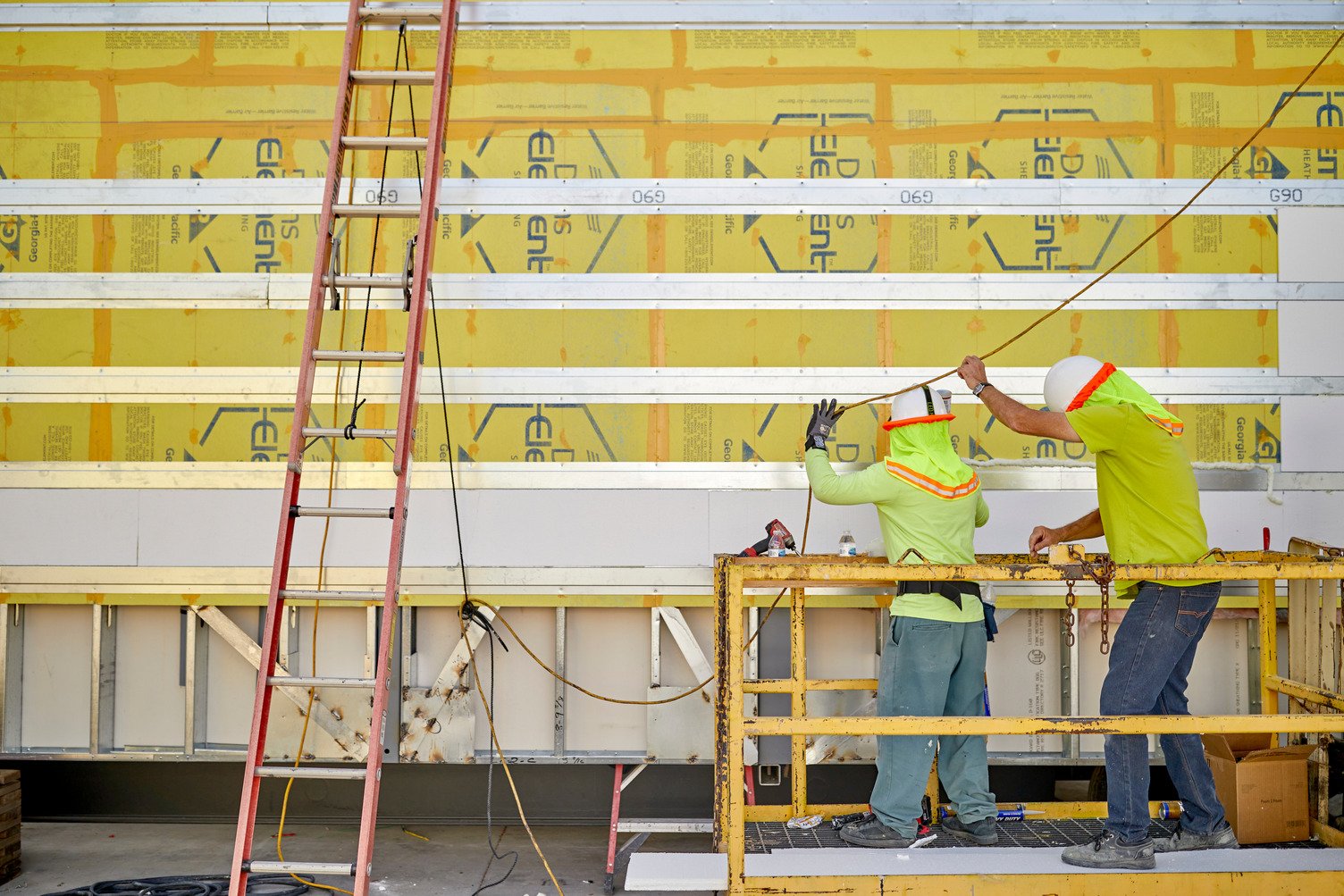Dodger’s Stadium: Integrated Sheathing Knocks Modular Concessions Construction Out of the Park

Renovating a popular sports stadium comes with its own set of time constraints and quality expectations. The moment the season ends, it’s time to hit the ground running for a quick construction turnaround before the next season begins. For most baseball fans, nothing’s more American than joining the roar of the crowd with beer and hotdogs in hand. So, to ensure the best fan offerings in time for when we’re all able to celebrate Opening Day again, the MVPs behind the Los Angeles Dodgers Stadium renovation knew they needed a homerun. Tackling such a massive construction undertaking would take a team effort, which is why the project’s general contractor drafted Arizona-based Accelerated Construction Technologies (ACT) to pinch-hit on a soon-to-be new fan-favorite aspect of the stadium’s transformation: concessions.
Built for Each Other
When the newly completed Dodgers Stadium reopens to the masses, it will feature—among countless other improvements—five new concession stands, each distinctly displayed to catch patrons’ eyes. Yet despite sporting custom designs, their construction still offered the opportunity to consolidate the process through modular production. This is where ACT came into play. Specializing in turnkey modular structure solutions, ACT is considered among the top-quality manufacturers of its kind in North America. ACT’s role in the overall stadium renovation was to build the concession stands to spec as fully as possible in their Arizona facility, before shipping the modular pieces to the California stadium’s construction site for assembly. This meant time was of the essence. They may be called concession stands, but don’t let the term fool you into underestimating the size of these structures. These aren’t your neighborhood sidewalk lemonade stops. Multiple factors made this project particularly tricky. ACT General Manager Angel Torres explained that modular production was chosen for the concession stands because vertical construction would not be able to start until after all the horizontal construction underground was complete. “To shorten the amount of construction time, we prefab while they’re doing the site improvements,” he said. “We did all aspects of the construction from framing, all the way to exterior and interior finishes. So, when they were done with the site improvement, we were already 75- 80% done with the prefabs.” If a tight timeline wasn’t enough of a curveball, the team roster also consisted of not one, not two, but three different architects on the project—which meant three different visions to execute on demand, while also securing everyone’s seal of approval. “They sort of design the modules as they go along,” noted Sam Spaulding, Georgia-Pacific field sales manager on the project. “A lot of inspections have to happen at different phases—not just from a building inspector, but also from the Dodgers organization.” And oh yeah, all of this needed to be done in about a month’s turnaround time. It was a crucial inning, and the bases were loaded. Production needed to go smoothly.
“Using DensElement®, I think that saved us a good 30-40% of the production time.”
‒Angel Torres, General Manager, Accelerated Construction Technologies
Baseball’s New Dream Team: DensElement® Barrier System and DensDefy™ Accessories
“We were supposed to be using thin glass, then waterproof it,” Torres said of the initial assembly plan. “But when my CEO researched online, he found DensElement®.” Integrating the sheathing and weather-resistive barrier and air barrier (WRB-AB) together in one sheet, DensElement® Barrier System removes the need for a separate weatherproofing application altogether. Filling microscopic voids in the glass mat and gypsum core via AquaKOR™ Technology creates a hydrophobic, monolithic surface that blocks bulk water while retaining vapor permeability. Then DensDefy™ Liquid Flashing completes the system, making the finish even easier by sealing all joints and seams for a tight continuous envelope.
“The reason they loved the product is because it’s a timekeeper” Spaulding said. “Some contractors are afraid to take on the waterproofing because of liability if it’s not done correctly. But they were more than willing to take that on.” ACT’s confidence in DensElement® Barrier System’s performance ability was in no small part thanks to Spaulding’s quality client service—meeting in person to demonstrate product usage, describe its benefits, and explain Georgia-Pacific’s limited warranty for 12 months of exposure to normal weather conditions. “Time was of the essence to deliver the building waterproof, and we had no idea if it was going to be exposed to weather for two weeks, three weeks, a month. DensElement®’s ability to be exposed to elements for an extended period of time was definitely a plus on the decision-making,” Torres explained. “And it was a lot easier working directly with one person to get all the materials and show us how to use them. We would have overused the material and spent much more otherwise.”
The opportunity to use the DensElement® Barrier System with DensDefy™ Liquid Flashing proved to be a game-changing play. By using a sheathing with the weatherproofing already incorporated into the board, the construction team was able to cut down on overall labor time and costs, keep the assembly line going without downtime waiting for an extra WRB-AB to dry, and avoid the overspray mess they usually have to deal with when using a fluid-applied barrier at their indoor facility. “It was one less step on the production line to go through,” Torres noted, adding that his laborers were already up to speed with how to install the sheathing and flashing together within a couple of hours. “Using DensElement®, I think that saved us a good 30-40% of the production time.” The whole building assemblies were three-dimensional by the time they left the factory—including mechanical, electrical insulation, and plumbing—with the DensElement® Barrier System outside. Ready for transport, the ability to transfer the pieces without damaging the weather barrier became a crucial benefit. “Not only did they realize the speed out of this system, but they also realized its ability to ship [without cladding] on the back of a truck,” Spaulding said. “It’s really cool how they do this. They built these modules, then they build custom trailers for them and ship them over. So, the DensElement® system really plays a big role in their ability to make money because, I’ll tell you, steel fabrication work on just the trailer alone is terribly expensive.”
For Torres, this was the moment of truth. “Our buildings flex during transportation, and the DensDefy™ was flexible enough to stay in place. We didn’t have to retouch the seams again.” All in all, the concession stands went from packaged materials in early February to onsite delivery at the beginning of March—enough time to spare before game time. Only one problem remained. “It was a fun project, even if it wasn’t for the Yankees,” noted Torres, a devoted New York fan. Well, can’t win ‘em all.
